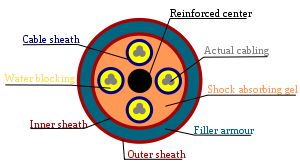- Direct-buried cable
-
Direct-buried cable (DBC) is a kind of communications or transmissions cable which is especially designed to be buried under the ground without any kind of extra covering, sheathing, or piping to protect it.[1]
Contents
Description
Most direct-buried cable is built to specific tolerances to heat, moisture, conductivity, and soil acidity. Unlike standard telecommunications and power cables, which have only a thin layer of insulation and a waterproof outer cover, DBC consists of multiple layers of heavy metallic-banded sheathing, reinforced by heavy rubber covers, shock absorbing gel, wrapped thread-fortified waterproof tape, and stiffened by a heavy metal core.
Benefits
Most cable of this kind is coaxial or bundled fiber-optic in nature. Direct-buried cable is cheaper and easier to lay than other kinds of cable that require protection from the earth.[1] However, DBC is also easily cut during digging or other excavations. As a result, most direct-buried cable is found on side roads, not main thoroughfares.[2]
DBC is preferable in some areas since it is more resistant to being the focus of lightning discharges.[3]
Power cabling
Some power cabling is also direct-buried. This kind of cabling must follow strict regulatory procedures regarding installation and backfilling. This is usually used in areas where overhead cabling is impractical or dangerous.
External links
References
- ^ a b Sterling, Donald J. (2000). Premises Cabling. Thomson Delmar Learning. ISBN 0766817350.
- ^ Highhouse, John (1997). A Guide for Telecommunications Cable Splicing. Thomson Delmar Learning. ISBN 0827380666.
- ^ Rakov, Vladimir A.; Uman, Martin A. (2003). Lightning: physics and effects. Cambridge University Press. ISBN 0521583276.
Categories:- Cables
Wikimedia Foundation. 2010.

